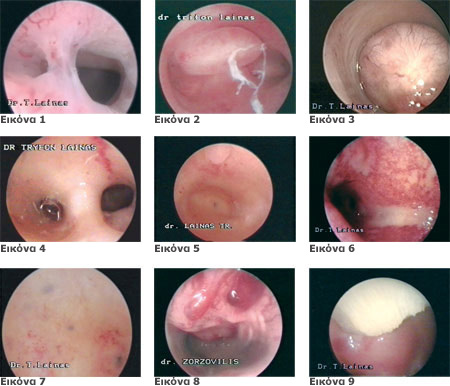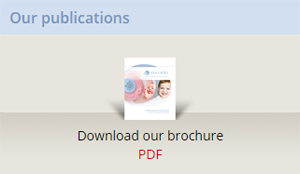This examination is useful for the diagnosis of the physiology or the pathology of the uterus and the endometrium.
The possible pathologies that can be diagnosed include (Image1 –Image 9):
- Endometrial adhesions (symphyses) (Image 1).
- Endometrial or cervical polyp (Image 2).
- Submucosal fibroids (Image 3).
- Congenital anomalies of the uterus (uterine septum, unicornuate uterus, uterus with double cervix, T-shaped uterus etc.) (Image 4, Image 5).
- Inflammation of the endometrium (endometritis) (Image 6). Endometritis has a characteristic hysteroscopic appearance, especially during the proliferative phase of the cycle. We can distinguish the characteristic spots, while there is hyperhaemia of the endometrium. The endometrium also appears covered in mottled white gland openings.
- Adenomyosis (Image 7, Image 8) During hysteroscopy the appearance of adenomyosis is characterized by brown or black spots similar to these observed laparoscopically in endometriosis.
- Osseous metaplasia (Image 9): it is a rare hysteroscopic finding that is associated with unexplained infertility.
- Scars in the endometrim from previous curretage or others procedures.
- Hyperplasia of the endometrium.
- Leftover tissue after prengnacy.
- Malignant neoplasias of the uterine cavity.

Image 1 – Endometrial adhesions (hysteroscopic image)
Image 2 – Endometrial polyp (hysteroscopic image)
Image 3 – Submucosal uterine fibroid (hysteroscopic image)
Image 4 – Uterine septum (hysteroscopic image)
Image 5 – Unicornuate uterues (hysteroscopic image)
Image 6 – Endometritis (characteristic hysteroscopic image)
Image 7 – Adenomyosis (hysteroscopic image)
Image 8 – Adenomyosis (hysteroscopic image)
Image 9 – Osseous metaplasia (hysteroscopic image)
Image 2 – Endometrial polyp (hysteroscopic image)
Image 3 – Submucosal uterine fibroid (hysteroscopic image)
Image 4 – Uterine septum (hysteroscopic image)
Image 5 – Unicornuate uterues (hysteroscopic image)
Image 6 – Endometritis (characteristic hysteroscopic image)
Image 7 – Adenomyosis (hysteroscopic image)
Image 8 – Adenomyosis (hysteroscopic image)
Image 9 – Osseous metaplasia (hysteroscopic image)






























